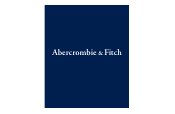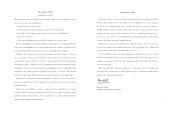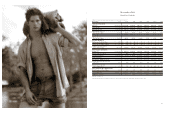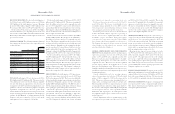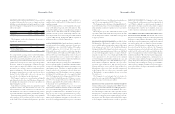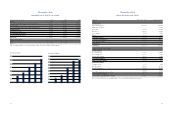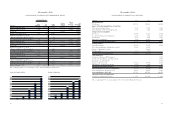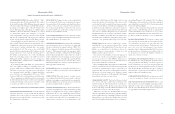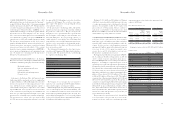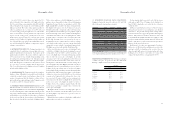Abercrombie & Fitch 2000 Annual Report Download - page 11
Download and view the complete annual report
Please find page 11 of the 2000 Abercrombie & Fitch annual report below. You can navigate through the pages in the report by either clicking on the pages listed below, or by using the keyword search tool below to find specific information within the annual report.
25
Abercrombie &Fitch
24
EARNINGS PER SHARE Net income per share is computed
in accordance with SFAS No. 128, “Earnings Per Share.”
Net income per basic share is computed based on the weighted
average number of outstanding shares of common stock. Net
income per diluted share includes the weighted average effect of
dilutive stock options and restricted shares.
Weighted Average Shares Outstanding (thousands):
2000 1999 1998
Shares of common stock issued 103,300 103,300 103,300
Treasury shares (3,239) (429) (216)
Basic shares 100,061 102,871 103,084
Dilutive effect of options and
restricted shares 2,095 4,770 3,118
Diluted shares 102,156 107,641 106,202
Options to purchase 7,875,000 and 5,690,000 shares of Class A Common Stock were
outstanding at year-end 2000 and 1999 but were not included in the computation of net
income per diluted share because the options’ exercise prices were greater than the aver-
age market price of the underlying shares. At year-end 1998, no anti-dilutive options
were outstanding.
USE OF ESTIMATES IN THE PREPARATION OF FINANCIAL
STATEMENTS The preparation of financial statements in con-
formity with generally accepted accounting principles requires
management to make estimates and assumptions that affect
the reported amounts of assets and liabilities as of the date of the
financial statements and the reported amounts of revenues and
expenses during the reporting period. Since actual results may
differ from those estimates, the Company revises its estimates and
assumptions as new information becomes available.
RECLASSIFICATIONS Certain amounts have been reclassified
to conform with current year presentation.
3. ADOPTION OF ACCOUNTING STANDARDS In the fourth
quarter 2000, the Company adopted Emerging Issues Task Force
(“EITF”) No. 00-10 “Accounting for Shipping and Handling
Fees and Costs” which changed its classification for shipping
revenue. The Company also changed its classification for direct
shipping expenses for shipments to customers to cost of goods sold
and for employee discounts to a reduction of revenue. All other
fulfillment costs are included in General, Administrative and
Store Operating Expenses. Previously, shipping revenues, certain
shipping expenses and employee discounts were included in
General, Administrative and Store Operating Expenses. Prior
periods’ financial statements presented for comparative purposes
have been reclassified to comply with these classification guidelines.
These reclassifications did not have an impact on net income.
The Company has adopted Staff Accounting Bulletin (“SAB”)
No. 101, “Revenue Recognition in Financial Statements.”
SAB No. 101 provides the Securities and Exchange Commission’s
views in applying generally accepted accounting principles to
selected revenue recognition issues. The adoption of SAB No. 101
did not have a material effect on the Company’s results of oper-
ations, cash flows or financial position.
4. PROPERTY AND EQUIPMENT Property and equipment, at
cost, consisted of (thousands):
2000 1999
Land $ 14,007 $ 14,007
Furniture, fixtures and equipment 212,674 158,753
Beneficial leaseholds 7,349 7,349
Leasehold improvements 31,613 19,572
Construction in progress 118,553 26,100
Total $384,196 $225,781
Less: accumulated depreciation and amortization 105,411 79,378
Property and equipment, net $278,785 $146,403
5. LEASED FACILITIES AND COMMITMENTS Annual store
rent is comprised of a fixed minimum amount, plus contingent rent
based on a percentage of sales exceeding a stipulated amount. Store
lease terms generally require additional payments covering taxes,
common area costs and certain other expenses. Rent expense for
1998 included charges from The Limited and its subsidiaries for
space under formal agreements that approximated market rates.
A summary of rent expense follows (thousands):
2000 1999 1998
Store rent:
Fixed minimum $65,716 $51,086 $42,774
Contingent 7,079 8,246 6,382
Total store rent $72,795 $59,332 $49,156
Buildings, equipment and other 2,777 2,574 1,814
Total rent expense $75,572 $61,906 $50,970
Abercrombie &Fitch
At February 3, 2001, the Company was committed to noncance-
lable leases with remaining terms of one to thirteen years. These
commitments include store leases with initial terms ranging
primarily from ten to fifteen years and offices and a distribution
center leased from an affiliate of The Limited with a term of three
years from the date of the Exchange Offer. A summary of min-
imum rent commitments under noncancelable leases follows
(thousands):
2001 $80,082 2004 81,060
2002 $83,014 2005 78,089
2003 $81,672 Thereafter 251,391
6. ACCRUED EXPENSES Accrued expenses consisted of the
following (thousands):
2000 1999
Accrual for construction in progress $ 24,371 $ 14,840
Rent and landlord charges 15,634 15,282
Compensation and benefits 11,771 11,588
Deferred revenue 11,636 8,482
Catalogue and advertising costs 7,818 7,005
Taxes, other than income 5,102 4,507
Other 24,970 23,669
Total $101,302 $ 85,373
7. INCOME TAXES The provision for income taxes consisted of
(thousands):
2000 1999 1998
Currently payable:
Federal $ 80,856 $ 84,335 $65,778
State 18,403 20,251 14,809
$ 99,259 $104,586 $80,587
Deferred:
Federal 2,814 (3,885) (10,038)
State 1,247 (971) (2,509)
$ 4,061 $ (4,856) $(12,547)
Total provision $103,320 $ 99,730 $68,040
A reconciliation between the statutory Federal income tax rate
and the effective income tax rate follows:
2000 1999 1998
Federal income tax rate 35.0% 35.0% 35.0%
State income tax, net of Federal
income tax effect 4.1% 4.6% 4.7%
Other items, net 0.4% 0.4% 0.3%
Total 39.5% 40.0% 40.0%
Income taxes payable included net current deferred tax assets
of $14.7 million and $14.2 million at February 3, 2001 and
January 29, 2000, respectively.
Subsequent to the Exchange Offer, the Company began
filing its tax returns on a separate basis and made tax payments
directly to taxing authorities. Prior to the Exchange Offer, the
Company was included in the consolidated federal and certain
state income tax groups of The Limited for income tax purposes.
Under this arrangement, the Company was responsible for and
paid The Limited its proportionate share of income taxes, calcu-
lated upon its separate taxable income at the estimated annual
effective tax rate. Amounts paid to The Limited totaled $829
thousand, $9.1 million and $27.4 million in 2000, 1999 and 1998,
respectively. Amounts paid directly to taxing authorities were
$111.7 million, $81.1 million and $31.7 million in 2000, 1999 and
1998, respectively.
The effect of temporary differences which gives rise to de-
ferred income tax assets (liabilities) was as follows (thousands):
2000 1999
Deferred tax assets:
Deferred compensation $ 8,311 $ 9,333
Property and equipment – 1,478
Rent 2,414 2,565
Accrued expenses 8,144 10,230
Inventory 2,767 1,650
Total deferred tax assets 21,636 25,256
Deferred tax liabilities:
Property and equipment (2,146) –
Net deferred income tax assets $19,490 $25,256
No valuation allowance has been provided for deferred tax
assets because management believes that it is more likely than
not that the full amount of the net deferred tax assets will be
realized in the future.

